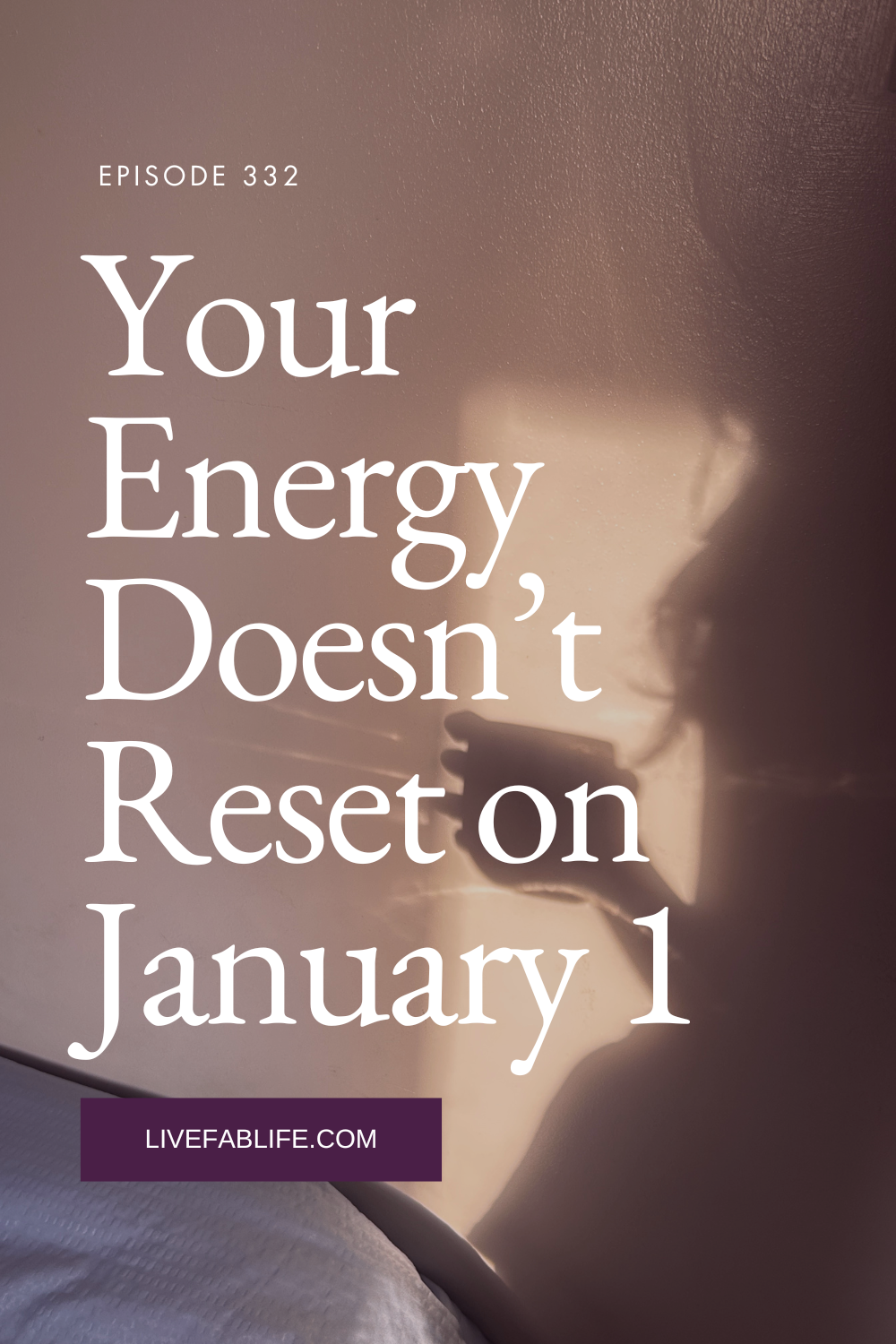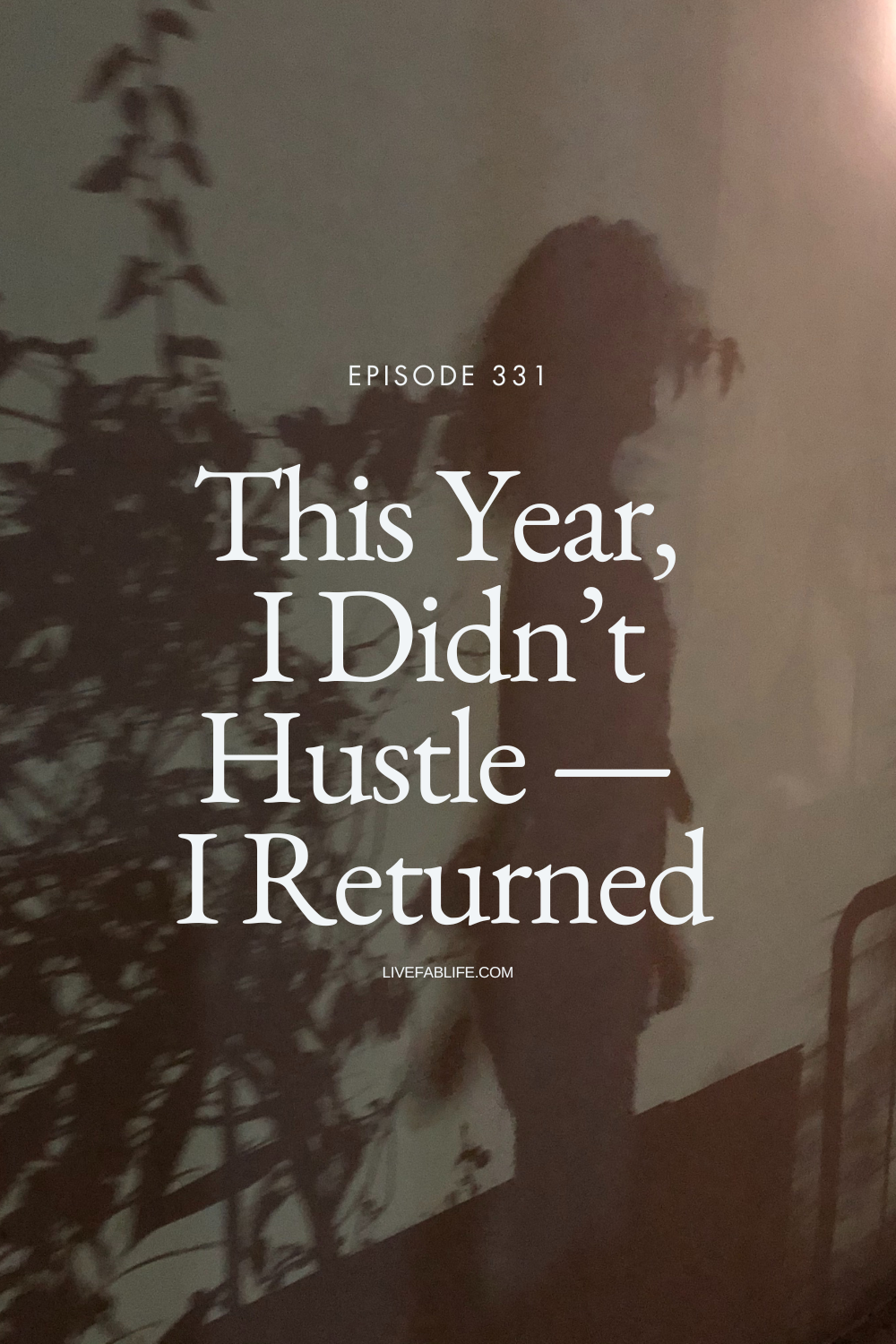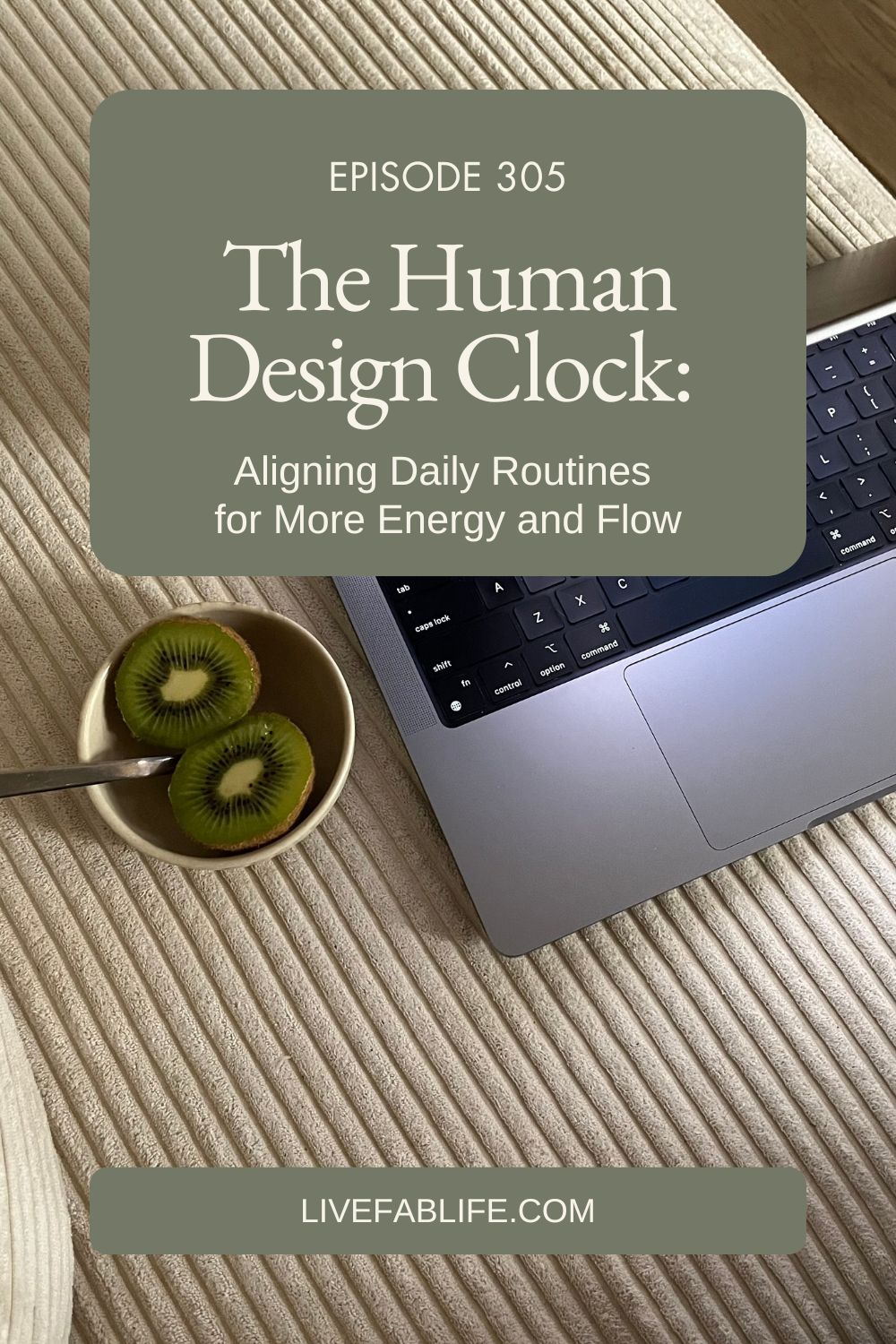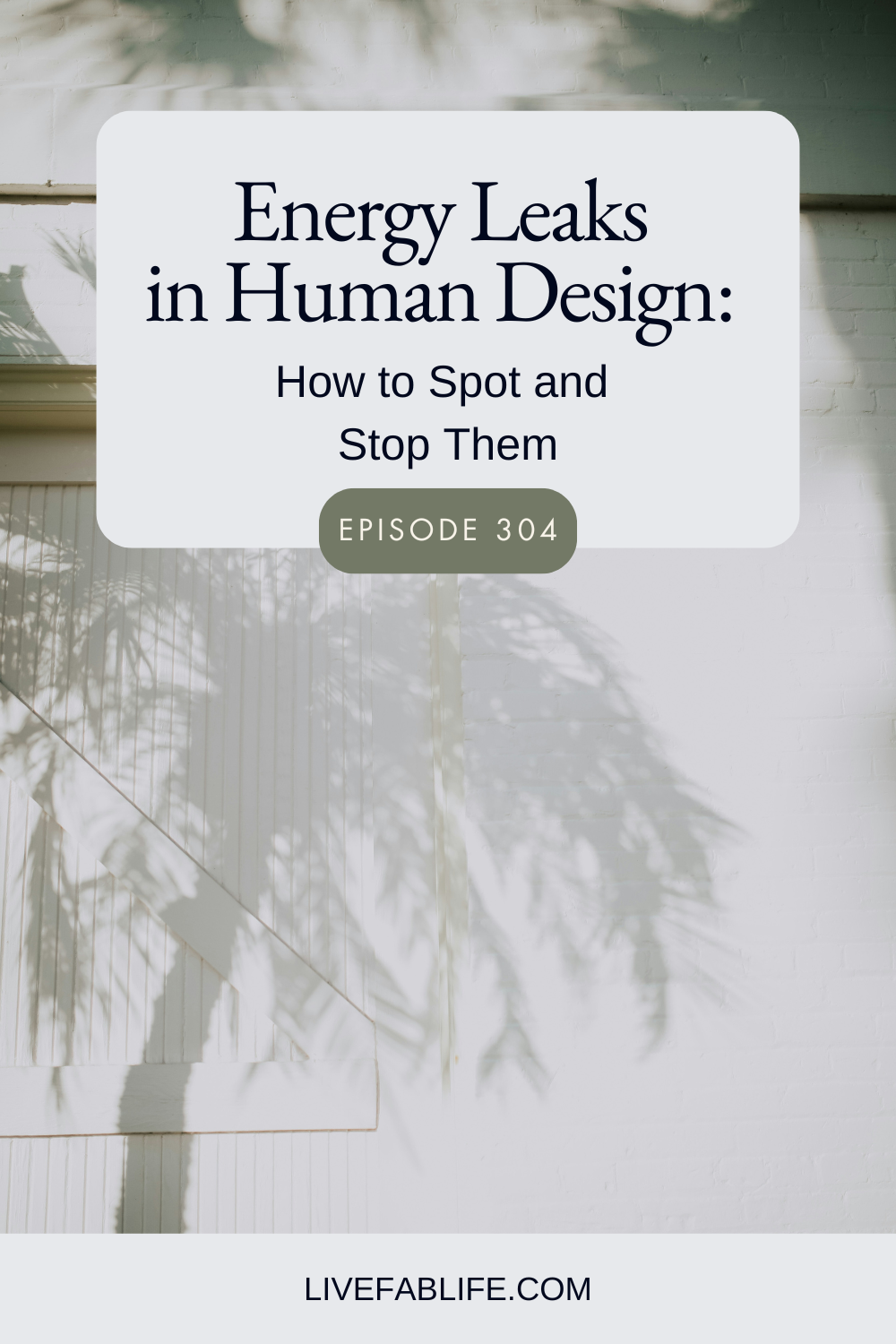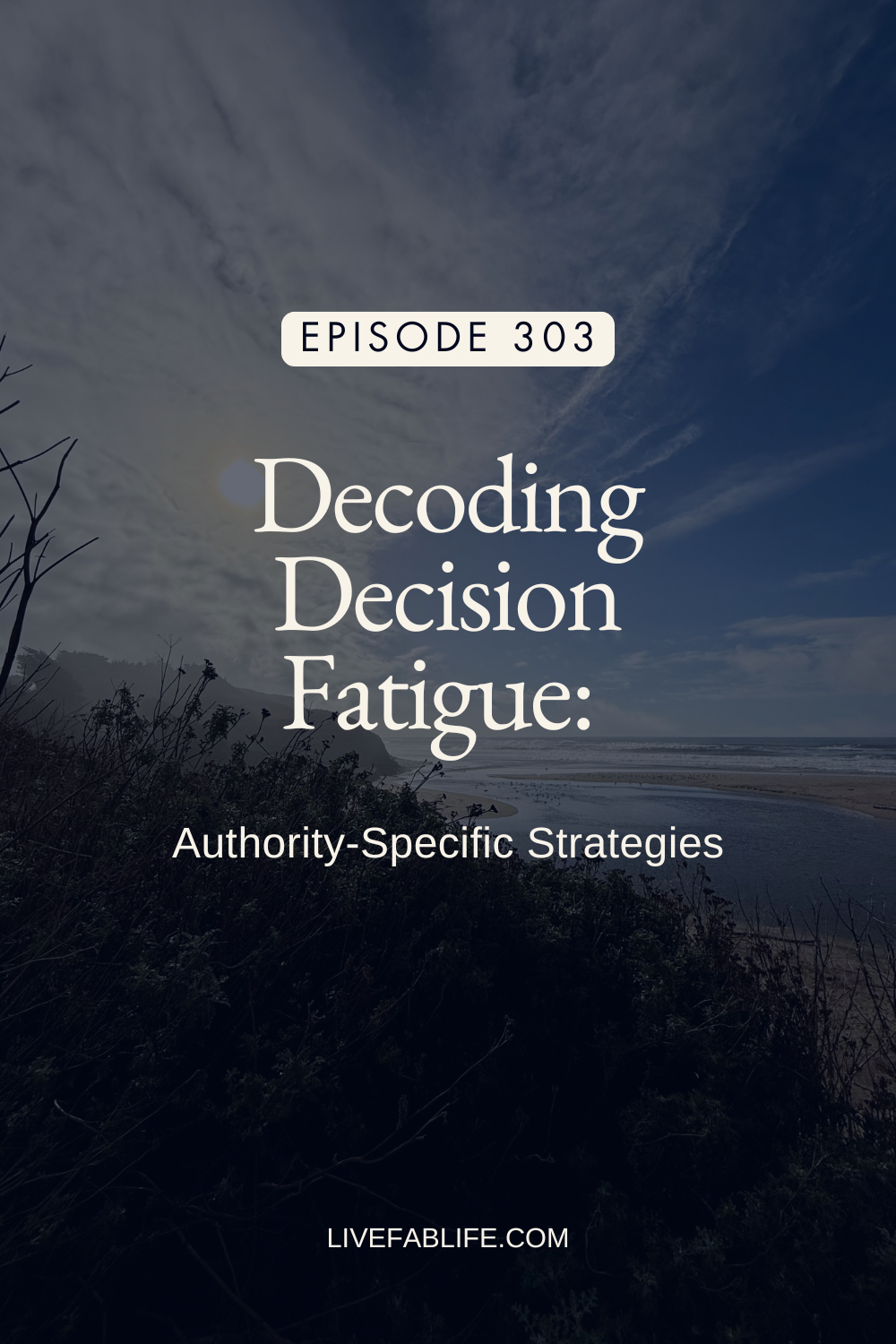Episode 169: Using Human Design to Avoid Burnout
In a society where we're expected to push ourselves to work and accomplish much as quickly as possible, it’s no wonder that burnout has become the accepted norm.
In this last installment of my three-part series on burnout, we explore Human Design and why you might be more susceptible to burnout than others.
I share with you how I use my Human Design to reframe my thought patterns and daily habits to avoid burnout.
Episode Highlights:
A recap of Parts 1 and 2 in this series on burnout
What areas of your Human Design chart can shed insight into whether you might be prone to burnout
How you can use Human Design to your advantage to manage your energy and avoid burnout
Listen to the Episode:
Mentioned in the Episode:
Episode 114: The Reality of Burnout (and What To Do About It)
Episode 168: Using Functional Nutrition to Recover From Burnout
Episode 153: Integrating My Human Design Type As A Projector
Episode 166: 166: A Foundational Breakdown of Your Human Design Chart
Connect with Naomi:
Share the Episode:
“I’ve come to learn that Human Design hasn’t told me anything that I didn’t already know about myself. It shed light on aspects of myself that I always knew were there, and I always knew were true. But I didn’t allow myself to explore, acknowledge or embrace those aspects of me. ”
Read the Transcript:
Hello, my friend, and welcome back to The Live FAB Life Podcast. Gosh, I'm so happy that you're here with me for this third part in our three-part series on burnout.
To quickly recap, Part One, in Episode 167, we defined what burnout is, and we talked about what are the signs and symptoms of burnout, and how it shows up for people. And you might even identify ways that you might have either been burnt out, or you might be burnt out right now.
In Part Two, in Episode 168, I shared how we can take a functional approach to addressing burnout using Functional Nutrition. By this we mean not just looking at what the signs and symptoms are, not just addressing those specific signs and symptoms, but taking a look at why are the signs and symptoms showing up to begin with? What's going on in the bigger picture? And how do we do that?
I walked you through my process of how I’ve helped my health coaching clients take a look at that, and we talked about how we can use the three ATM’s - the Antecedents (looking at any predisposing genetics that might be in play), the Triggers (things that evoke the symptoms to appear), and the Mediators (what are the things that contribute to the signs and symptoms manifesting, or even what are the things that contribute to healing to remedy the situation and remedying your health).
I walked you through my process of coaching that I take my clients through, using Functional Nutrition which looks at the external factors that can cause burnout, using nutrition and lifestyle to address them.
But we took things a step further, considering what's really at the root of burnout. And we started looking at it internally.
I shared with you my process of using self-observation with nonjudgement to take note and create awareness of what some of those ATM’s might be. Then the importance of understanding what your priorities are - not the priorities of what's expected of you, but what truly is important for you right now at this point in your life.
Then we talked about the importance of establishing boundaries to help you really honor those priorities, and the importance of communicating those boundaries so that not just other people can uphold those boundaries, but you can uphold them for yourself as well. Today, in Part Three, we're going to take a look at how Human Design can help you deepen that internal work to help you address burnout.
Now, if you're not familiar with Human Design, I really encourage you to stop here and listen to Episode 166, where I explain the foundations of Human Design and specifically walk you through the Human Design body graph chart. If you've ever looked up your Human Design, you know what it is I'm talking about.
When we defined burnout, we said that it’s what happens when we're under chronic, prolonged stress, right? At the root of burnout is chronic stress and chronic is when it happens for a prolonged period of time.
Now with prolonged chronic stress comes tension. As stress builds up in your body, so does tension. So, what causes that tension? What causes chronic stress and tension to build up?
If you want to look at it from a really deep way, I found that it really comes from feelings of inadequacy, which if you think about, examine and observe it, feelings of inadequacy are really rooted in comparison syndrome.
We don't feel inadequate unless we're comparing ourselves to something or someone else.
I have a great example for you on this. You know, I grew up not a very athletic kid. I was always picked last for PE teams. I never played sports as a kid or in high school as a teenager. This was something that I was always very self-conscious about.
As an adult, I decided that I wanted to get healthy and get active, so I joined a gym. I worked with a personal trainer and really came to understand the importance of warming up the body and taking care and fueling the body, which then led me to find exercising and working out actually quite enjoyable.
From there, I turned to running and really got into it. I was so surprised yet proud of this because running was something I never enjoyed. I was always the last one to finish a race or finish the whatever, 600-meter dash in PE class, or whatever it was. I didn’t find it enjoyable.
So as an adult, realizing that I can actually run a mile, that I could actually run three miles, or even five miles, I found myself training to do 5K's, 10K's, half marathons and full marathons.
It felt like finding a part of myself that I never knew existed. I found so much enjoyment in this until I connected with other runners in the running community, through running blogs and social media.
From there I realized that “Oh, I'm actually not that great at running because I don't run as far as other people, and I definitely don't run as fast as other people.” And when you're in the world of running these races, even as a novice because clearly most of us are not professionals, everything is measured. We’re measuring our pace, timing, mileage, and so being constantly compared to others, mostly by myself, to my pace, distance, and times, it really did make me feel inadequate. It robbed me of the joy that running initially brought me. It left me feeling sad, depressed, frustrated, envious, resentful, bitter, and sometimes angry, definitely feeling like I wasn't good enough.
This is exactly what feeling of inadequacy rooted in comparison syndrome is.
I'm fairly certain that I'm not the only one to feel this way, not just in running, but in many different other situations.
Some of the questions that come up when we’re faced with this is, “Why does life seems so much easier for so and so (insert someone's name) and not for me?”
You might look at a friend whose life may be seemingly charmed and easy, and wonder, “Why am I having so much hardship, and this person doesn’t?”
“Why am I so unmotivated?”
“Why don't I have the willpower to do whatever it is you're trying to do?”
And so and so on?
“Why can't I be consistent with (insert whatever you're trying to be consistent) when so and so doesn't have a problem with this?”
What this does is it leaves us feeling lost, and not knowing or questioning what our purpose is, searching for direction.
This is where Human Design can help you find some answers to these questions. I know that I've said Human Design can help you “understand you.”
I know that can sound really abstract and it does not feel like there’s a lot of credibility behind it. I get it, I understand it. You know, when the first time I hear something like this without any context or any deep understanding on my part, I kind of think the same thing too.
But here's the thing, now that I've taken some time to understand and study, not just my Human Design, but in general, what Human Design is, in my experience, I’ve come to learn that Human Design hasn't told me anything that I didn't already know about myself.
It shed light on aspects of myself that I always knew were there, and I always knew were true. But I either didn't allow myself to explore, acknowledge or embrace those things.
So, let's take a look at how elements of your Human Design body graph chart can help you specifically address burnout.
In Human Design, there are different Types. Three of the Types are what's called “energetic” types, and they're based upon what centers on one's Human Design body graph chart are “defined.”
Again, if you haven’t listened to Episode 166, this is not going to make sense to you, so yet, I strongly urge you to go listen to that episode, then come back to this one.
So, the three energetic Types are the Generator, the Manifesting Generator and the Manifestor.
The other two Types, the Projector and the Reflector are what's called “non energetic” Types or non-energy Types, again, determined by what centers in one's body graph are “defined” and what's “undefined.”
As you may know, I’m a Projector so I’m a non-energy type. Do you know what your type is?
If you’re a non-energy type, are you operating as an energy type?
As a Projector, in hindsight, I’ve come to realize that for my entire life I have been conditioned to work, live and operate as a Manifesting Generator.
I think I’ve shared before in past episodes that I looked up the Human Design charts of every person in my immediate family, and every person of significance at various times in my life, those who have been very close to me.
Every single one of those people are Manifesting Generators! So, I have been completely conditioned to be a Manifesting Generator. If you are familiar with the Manifesting Generator, then you know that they’re the most energetic of all the five Types.
Yet here I am a Projector, a non-energy type. So, I was conditioned to believe that I needed to multitask in order to be productive. I don't know how many times in my 20s and 30s. I mean, I haven't written my resume since my 30s, but you know, back in the day, on my resume, I would always write “multitasker” or “great at multitasking,” because it's perceived that that's a good trait to have, especially for an employee looking for a job, right? It's helps sell yourself to a hiring manager, and I was conditioned to believe that we want to do as much as possible in the shortest amount of time, and that taking on too much is not a bad thing.
So, that’s what I always did. I took on more than I was able to handle, I definitely wasn’t realistic about this.
In my younger years, I had a hard time with being able to say “no”, and I didn't have the skills or the abilities to set boundaries and communicate them. I was so conditioned to feel that I had to keep up with everything else.
I mean, is that just not a great reflection of my time in the running world, wanting to keep up with everyone else? Comparing myself to other people? It was this whole conditioning thought process that I’d been raised with.
So, if you think about it, society as we know it, is really built for Manifesting Generators and Generators. 35% of the population are Manifesting Generators and 35% are Generators. So, 70% of the population are energy types, so it's no wonder that we have 40-hour work weeks, five-day work weeks, and we get two weeks off of vacation a year, usually two weeks of vacation a year.
Society as we know it, at least when it comes to work, is really set up for Manifesting Generators and Generators.
So, for those of us who are Projectors and Reflectors, and to a degree Manifestors, we're just desperately trying to keep up with them.
And we're not able to, so it's no wonder so many of us are burned out.
I talked about how Defined and Undefined centers determine your Type. So, I want to quickly go through what those are, and again, Episode 166, goes through this in much more depth.
But basically, your Human Design body graph chart has nine different centers, that are either Defined or Undefined / Open.
The Defined Centers are where the energy of that center consistently flows through you, and the Undefined or Open centers are where, the energy inconsistently flows through you.
Some people think, “Well, I have an open or undefined center, so don't have the energy from it, and that's not true. We all have the energies of the different centers; we just don't experience them consistently or in consistent ways.
The undefined and open centers are where we’re vulnerable to take on the energy of other people.
Now, I do want to say one thing: there’s a perception that if a center is defined for you that you're good there, and you only need to worry about your undefined or open centers.
But I just want to pose this thought to you that you can have the consistent energy of a center but consistently experience it in an unhealthy way.
For example, I have a defined Throat center. The Throat center is the center of communication - speaking your truth.
I believe I have experienced this in unhealthy ways at different points of my life. So, I just want to put that thought in your head there when you're thinking about defined and undefined centers. But what I really want to do when addressing this for burnout is focus on three specific centers. First is an Undefined Head center.
The Head center sits at the crown at the top of your head. It’s where ideas and insights come from. When you have an Undefined Head center, you can be easily overwhelmed with the ideas and inspiration that comes to you, and you can also be easily overwhelmed with doubts and questions. Because we’re also vulnerable in our undefined and open centers, you can also take on the doubts and the questions and the worries of other people. You also might feel the need to resolve whatever doubts or problems there might be.
And while you might never run out of ideas or inspiration, you also have this need to feel like, you want to take action on all of them, immediately! Imagine how that can lead to burnout.
As someone who has an undefined Head center, I totally relate to this. I always have so many ideas running through my head, I have notebooks everywhere, which can also cause overwhelm because my ideas feel so scattered.
When other people come to me with their worries, doubts or problems, I can sometimes relate them, and I want to fix it for them! I want to solve their problems for them, and I want to do it now.
Or, if I get a new idea, I want to take action on it and do something about it now.
So, it's no wonder that my Apple Notes app (where I quickly go to jot down ideas), is a hot mess. I was trying to clean it out this morning, and I think I had close to like 600+ notes there, and they're mostly impartial or incomplete ideas, some that has been there for 3+ years. They’re ideas that I jotted down and got into my head and might have started taking action on, and then never really finished it because I moved on to something else. So, it's very easy for me with an undefined Head center to feel scattered or take on the problems of others when you have an undefined Head center.
Can you see how it can lead to burnout? It's like, it’s just so much, you just feel overwhelmed.
Another center I want to talk about today is the undefined Sacral center.
I’m also an undefined Sacral center.
If you’re a Manifesting Generator or a Generator, you have a defined Sacral center. This is what determines if someone a Generator or Manifesting Generator, you know, the energy types with the most energy, because the Sacral center is that the lifeforce energy of the Human Design chart.
And because 70% of the population are Manifesting Generators and Generators, like I said, it’s no wonder we're conditioned to believe that multitasking is good, because the majority of the people have the energy of a defined Sacral center!
They have the energy to do more than one thing at a time. They can actually take on a lot of different things and be really good at it! This is why society really supports the energy of the Manifesting Generator and Generator, because the majority of the population aligns with it, from our 40-hour work weeks, and our five-day work weeks, and only two weeks a year of vacation.
Although I know, if I have any international listeners, I know that at least in Europe, you take your at least month-long summer holiday, and I applaud you and am envious of you for that.
Those of us who have undefined Sacral centers, and this is you know, at least 30% of the population, we’re non-energy types (with the exception of Manifestors).
So, for us, energy management is critical.
Let me ask you this:
How do you manage your energy?
What boundaries do you have in place to manage your energy?
How do you communicate those boundaries?
What can you say “yes”, and what can you say “no” to?
And most importantly, how do you incorporate rest into your day-to-day?
Speaking of rest, I just want to say that even if you are a Generator or Manifesting Generator, or especially a Manifestor, you still need rest. Just because you have the most energy of all the types, doesn’t it mean that you don't need rest. We all need rest. It’s just as non-negotiable for you as well. I don't want to make it seem like you don't need it. You do, but how do you prioritize your rest?
If you don't, how can you start prioritizing your rest?
This is something that I have evolved to particularly over the past year, because I’ve struggled with burnout so much as shared in the past two episodes. But these days, what rest looks like for me, and I realized that I actually have a really flexible working situation and acknowledge that not everyone has the same flexibility that I do, but you can get creative, and we can think of ways to help you incorporate rest into your day.
This is the way that works for me: I take three walks a day, usually about 20-30 minutes each time, because I have a dog and I live in an apartment. So, if I don't take these walks, my dog doesn't go to a bathroom. So, I take three walks a day with Coco Pop.
Recently, I mean, recently since February, I’ve started to incorporate at least a minimum of 20 minutes of yoga into my day. This really started because I hurt my back in February, and the only thing that I found relieve the pain was yog and it's become something that I found I actually enjoy. So, I've kept it up, today was my 65th consecutive day of doing at least 20 minutes of yoga. I usually do it at the very start of my day, and it's worked out well because I find that I actually don't have a lot of energy to do a really intense workout first thing in the morning.
Tie to my undefined Sacral center, I can see how I used to force myself to get my early morning run in during my running days, because it's the coolest time of the day, and I'm very heat sensitive. But to be honest, it was miserable, because I didn’t have that energy at that time of day.
So doing yoga really works well for me, at least for right now, so I'm just going with it.
Other ways that I incorporate rest throughout my day is I try to pack my meetings, phone calls, the things that require the most mental energy in the mornings, and then either lightly schedule my calendar or earmark more mindless tasks that don't require as much energy for the afternoon.
So far, this has been working well for me, and I've been doing this as much as possible, especially over the past year. It doesn't always happen because I don't always have control over my calendar, but I currently work a lot with people in Europe, Asia, and on the East coast so this been really working with my schedule as most of my meetings take place in the morning.
Then the tasks that require the most thinking or the most brain energy, I try to make those happen before lunch as well. Then I take my lunchtime walk, and the more menial tasks, I schedule those and set those aside for the afternoon.
Another thing that's critical to managing my energy is that I have the same bedtime every evening that's usually between 9:15 and 9:45 pm.
If I can fit a power nap into my afternoon, I do that too, but it definitely doesn’t happen every day. But on the days that it does own, my goodness, I wake up from that power nap, whether it be 10, 20, or 30 minutes, and it's like this newfound energy where I feel like I'm just starting the day, and can tackle the day all over again.
This is really how important managing your energy is.
Okay, so we talked about the undefined Head center, and we talked about the undefined Sacral center.
Lastly, I want to talk about the undefined Root center. The Root center is at the base of the body graph chart. It’s the center for your adrenal glands. On a call earlier today, I learned that 40% of the population has an undefined Root center.
The Root Center is a pressure center, and those who have the center defined are really calm under pressure. Those of us who have this center undefined, it’s also undefined for me, those who have an undefined or open Root center, we’re more challenged under pressure.
We're not as calm or as graceful under pressure as those who have this center defined. Now, for those of us who have this center undefined or open, we're going to do what we need to do to quickly make that pressure go away.
For example, I tell myself this all the time, when something feels heavy, or challenging, or is going to take a lot of energy out of me, I just want to get through it really quick. “Let me just finish this one thing, and then I can relax.” That's a classic, undefined Root center.
Remember, in undefined centers, we take on the energy of other people. When we have an undefined Root center, we really feel pressure. It’s important to be constantly asking ourselves constantly, “Who's pressure am I feeling here? Is this my pressure, or is it from someone else?”
If I'm feeling pressure to deliver something, or to meet a quota, or deadline, am I invoking this on myself? Is this pressure that I'm feeling directly from me? Or is it someone else that I'm getting it from and picking up on someone else's energy? Am I trying to meet someone else's expectation of me?
Self-observation with non-judgement helps us create awareness that helps us really get clear on what OUR priorities actually are. Then, it’s so important to establish boundaries and communicate what those boundaries are. These are all key tools that I think we all can utilize here.
Like Functional Nutrition, what I talked about in the last episode, Episode 168, this is really deep work.
So much of Functional Nutrition and Human Design is about understanding what we've conditioned to be or believe, and then doing the work to decondition those things.
If you think about it, this is really what so much of the work that I do is about.
I'm a coach for the 21-Day Sugar Detox program, and that program is all about deconditioning what we've come to believe as food, and re-learning what real food actually is, and how can we eat in a healthy way that's suited for us, individually with our bio-individuality.
And that's so much what Functional Nutrition is, and what Human Design is - that deconditioning, and re-learning what's actually our priorities, what's actually important to us and who we truly are.
This is why I find Human Design incredibly empowering, because instead of just accepting perceived limitations, it really, at least for me, helped provide me with a perspective of how and why I'm different from someone else, and embracing that difference versus feeling like I'm lacking in comparison to something or someone else, or that I'm not good enough.
I'm just different in a different way.
I really think that when we come to this realization, it can help us so much with burnout, because:
1: We have a deeper sense of appreciation for ourselves. 2: It can help us show up in a way that brings us more joy, contentment and happiness, so that there's less of this feeling of comparing ourselves to others, of inadequacy, of chronic stress and tension.
3: We can make decisions that might be better for ourselves because when we're operating in a way, that's, you know, if you’re a Projector and I'm operating as a Manifesting Generator, that's going to burn me out.
If I don't recognize the openness of my undefined centers, and the vulnerability that brings me, if I try to, be something that I'm not, that's going to drain me. I’m going to make decisions that maybe aren't the best for me. Ultimately, it's going to lead to burnout.
What Human Design does is gives us insight and perspectives of how we can better manage our energy. I see how we're all doing a poor job of this, and we can definitely do a better job at managing our energy.
It gives us the tools on how to best create opportunities for ourselves, how we can best make decisions that really feel like it fits us, and then how we can best offer our gifts to the world.
We all have gifts to offer, but what's the best way to go about doing that in a way that we can be seen and appreciated by others.
By embracing and following our Human Designs, we can find that contentment, satisfaction and joy, most importantly in ourselves, then that just that'll translate into the rest of our lives and give us energy to do the things that we need to, when we want to, so that we can show up in the ways that we want to show up.
So, if you know your Human Design, how are you incorporating it day-to-day?
If you don't know your Human Design, you can look it up at www.geneticmatrix.com. This is the website that I use, and I'll link to it in the show notes. You can find the show notes for this episode on my website at www.livefablife.com/169 for Episode 169.
If you’d like to break down your chart and understand how you can integrate it into your daily life, you can learn more about booking a session with me at www.livefablife.com/services.
This wraps up our mini-series on burnout, but it definitely won't be the last time we talk about it, because it's such a critical part of the work that I do that I'm always going to be dealing with it.
I hope this series has been helpful. I'd love to hear your thoughts. You can connect with me on my website or find me on Instagram, where I hang out the most. You can find me there at @livefablifewithnaomi.
Thank you so much for listening. Like I always say, I always recognize that your time is valuable. We only get 24 hours in a day. We literally can't make more time, and so whatever time you spend with me here, you're obviously invested because you got to this point of the episode, and I just want to let you know that so appreciate your time, attention and listening to the entire episode. I hope it's been valuable for you.
With that, I'll see you right back here again next week. Thanks. Bye!
Naomi Nakamura is a Functional Wellness & Human Design Coach. She helps women who struggle with stress, fatigue, and burnout find freedom and empowerment by optimizing their health, finding balance, and upgrading their energy so they can live life on their own terms.
Combining her diverse professional background, and her unique approach integrates Functional Nutrition and Human Design she guides clients on a highly individualized journey of self-discovery, observation, and integration by removing physical, mental, and emotional confusion and overwhelm, simply taking them back to the very basics of health through their Human Design.
She believes that when our bodies function optimally, our personalities and souls can shine through everything that we think and do with empowering clarity and ease.
Naomi resides in the San Francisco Bay Area and can often be found exploring the area with her puppy girl, Coco Pop!
Connect with Naomi on: Instagram
| Pinterest

